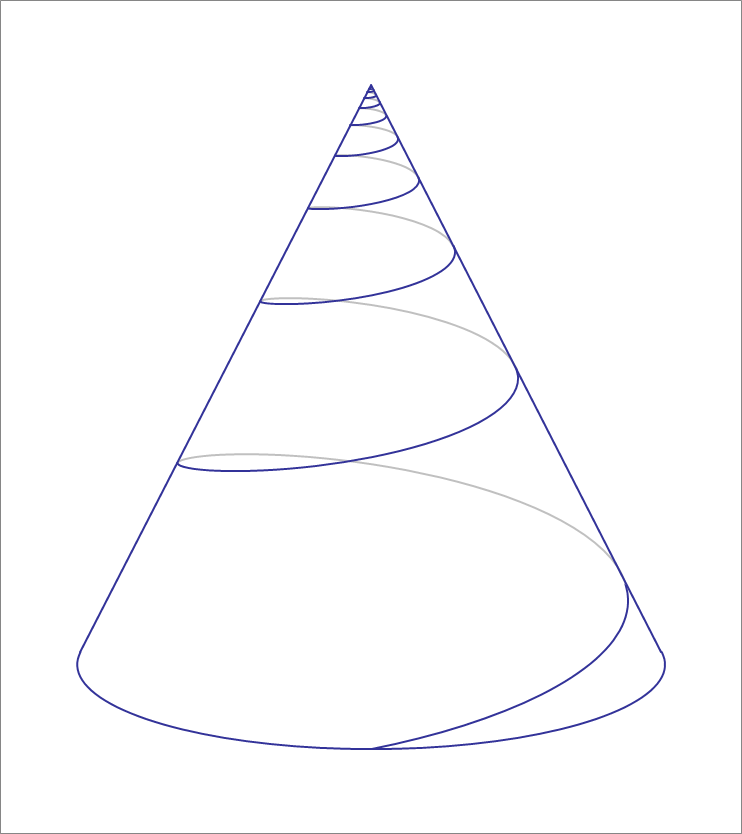Length of Path Along a Cone Surface

A right circular cone has a base radius of 2 5 units and a height of 5 0 units. You want to climb the cone from the base to the top, such that the tangent to the curve of your path always makes an angle of 1 0 ∘ with the horizontal plane. The cone and the path are depicted in the above figure. Find the length of this path.
The answer is 287.9385.
This section requires Javascript.
You are seeing this because something didn't load right. We suggest you, (a) try
refreshing the page, (b) enabling javascript if it is disabled on your browser and,
finally, (c)
loading the
non-javascript version of this page
. We're sorry about the hassle.
2 solutions
From the symmetry of the cone, it is convenient to use cylindrical coordinates to describe the surface of the cone. The equation of the surface is given by
p ( r , t , z ) = ( r cos t , r sin t , z )
Where I have replaced the polar angle ϕ with the letter t .
Now, for a cone with height H and radius of base R, and using similar triangles, we deduce that
( H − z ) / r = H / R
Hence r = R / H ( H − z ) = R ( 1 − z / H )
Therefore, the equation of the surface of the cone is
p = ( R ( 1 − z / H ) cos t , R ( 1 − z / H ) sin t , z )
Now we'll create a path on the cone surface, so z is a function of the angle t .
The only constraint we have is that the angle between the tangent vector to the track and the z-axis is equal to a 0 , where a 0 = 9 0 ∘ − 1 0 ∘ = 8 0 ∘ . Differentiating the position vector p with respect to the polar angle t , we get,
d t d p = p ˙ = ( − R / H z ˙ cos t − R ( 1 − z / H ) sin t , − R / H z ˙ sin t + R ( 1 − z / H ) cos t , z ˙ )
where z ˙ = d t d z ; then, using the dot product with the z unit vector, the angle that the tangent vector (which is p ˙ ) makes with the z -axis is ψ , where
cos ψ = cos a 0 = z ˙ 2 ( ( R / H ) 2 + 1 ) + R 2 ( 1 − z / H ) 2 z ˙
this determines z ˙ in terms of z , t . Namely, by squaring and cross multiplying,
cos 2 a 0 . z ˙ 2 ( 1 + ( R / H ) 2 ) + R 2 ( 1 − z / H ) 2 = z ˙ 2
Solving for z ˙ , one obtains,
z ˙ 2 ( 1 − cos 2 a 0 ( 1 + ( R / H ) 2 ) ) = cos 2 a 0 R 2 ( 1 − z / H ) 2
so that,
z ˙ = k 0 R ( 1 − z / H )
where k 0 = cos a 0 / ( 1 − cos 2 a 0 ( 1 + ( R / H ) 2 ) ) ( 1 / 2 )
We can now solve for z ( t ) , by separating the variables z and t . We have,
( 1 − z / H ) d z = k 0 R d t
Integrating from z = 0 to z , and t = 0 to t
− H ln ( 1 − z / H ) = k 0 R t
so that,
1 − z / H = e − k 0 ( R / H ) t
and finally,
z = H ( 1 − e − k 0 ( R / H ) t )
Now, the length of the path is given by,
L = ∫ t = 0 ∞ ∣ p ˙ ∣ d t
= ∫ t = 0 ∞ ( 1 + ( R / H ) 2 ) . ( k 0 R e − k 0 ( R / H ) t ) 2 + R 2 ( e − k 0 ( R / h ) t ) 2
= ∫ t = 0 ∞ ( 1 + ( R / H ) 2 ) . k 0 2 R 2 + R 2 e − k 0 R / H t
= k 0 ( R / H ) 1 ( 1 + ( R / H ) 2 ) k 0 2 R 2 + R 2
= k 0 H ( 1 + ( R / H ) 2 ) k 0 2 + 1
This, when simplified, turns out to be,
L = cos a 0 H = cos 8 0 ∘ 5 0 = sin 1 0 ∘ 5 0 = 2 8 7 . 9 3 8 5
Observe that the height of the path (h) purely depends on its arc length (s) with the relationship d s d h = t a n ( 1 0 º ) , so WLOG we may treat the path as the hypotenuse of right triangle with incline 10º and height of length 50. Hence the answer is s i n 5 0 º 5 0 ≈ 2 8 7 . 9 3 8 5 .